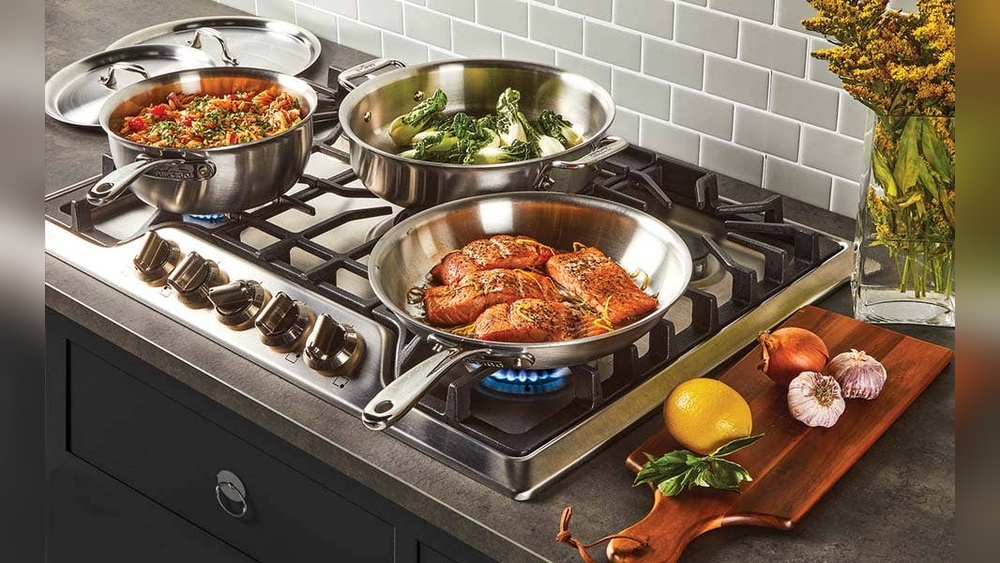Are you ready to unlock the full potential of your stainless steel pans? Cooking with these versatile tools can transform your meals, giving you perfect sears, rich flavors, and easy cleanup—once you know the tricks.
If you’ve ever struggled with food sticking or uneven cooking, this guide is made just for you. By the end, you’ll feel confident and excited to cook like a pro, using your stainless steel pans to their fullest. Keep reading, and discover simple steps that will change the way you cook forever.

Credit: www.reddit.com
Choosing The Right Stainless Steel Pan
Choosing the right stainless steel pan is key for good cooking results. The right pan can make food cook evenly and prevent sticking. It also lasts longer and is easier to clean. Picking the best pan depends on how you plan to use it and your cooking style.
Types Of Stainless Steel Pans
Stainless steel pans come in many types. Fry pans are flat and good for frying or sautéing. Sauce pans have tall sides, perfect for making sauces or boiling. Stockpots are large and deep, ideal for soups or stews. Some pans have a copper or aluminum core to spread heat better. Choose a type that fits your common cooking tasks.
Size And Weight Considerations
Size matters for stainless steel pans. Small pans work well for single meals. Larger pans suit families or batch cooking. Weight affects how easy the pan is to handle. Heavy pans heat evenly but can be hard to lift. Light pans are easier to move but may heat unevenly. Pick a size and weight that match your kitchen and cooking needs.

Credit: www.reddit.com
Preparing Your Pan For Cooking
Preparing your stainless steel pan before cooking is essential. It helps food cook evenly and stops sticking. Proper prep makes cooking easier and cleanup faster. Follow simple steps to get your pan ready for the best results.
Seasoning Techniques
Seasoning your stainless steel pan creates a smooth surface. Start by heating the pan on low heat. Add a thin layer of oil with a high smoke point, like vegetable or canola oil. Let the oil heat until it shimmers. Turn off the heat and let the pan cool. Wipe out any excess oil with a paper towel. This process helps food release better and keeps the pan in good shape.
Preheating Tips
Preheating your pan evenly stops food from sticking. Place the pan on medium heat for a few minutes. Test the heat by sprinkling a few drops of water. If the drops dance or sizzle, the pan is ready. Avoid overheating, as this can damage the pan and cause food to burn. Preheating helps you cook food with a perfect sear and even texture.
Mastering Heat Control
Controlling heat is key to cooking well with stainless steel pans. These pans heat differently than non-stick ones. Learning how to manage heat helps prevent food from sticking or burning. It also helps cook food evenly and keep flavors pure.
Stainless steel pans respond quickly to changes in heat. This means you must watch your stove settings closely. Small adjustments can make a big difference in cooking results.
Understanding Heat Levels
Low heat is best for gentle cooking and simmering. Use it for sauces or melting butter. Medium heat suits most cooking tasks like sautéing vegetables. High heat is for searing meat or boiling water fast. Avoid using very high heat for too long. It can damage the pan and burn food.
Start with medium heat and adjust as needed. Stainless steel pans take a moment to warm up. Wait for the pan to get hot before adding food. You can test heat by sprinkling a few drops of water. If they dance or evaporate quickly, the pan is ready.
Avoiding Hot Spots
Hot spots are areas on the pan that get hotter than others. They cause uneven cooking and burnt patches. Stainless steel pans can develop hot spots if heat is too high. To avoid this, use medium or medium-low heat most times.
Move food around often while cooking. Stir or shake the pan to spread heat evenly. Use flat-bottom pans that sit well on the burner. Make sure the pan size matches the burner size. This helps distribute heat properly.
Cooking Techniques With Stainless Steel
Cooking with stainless steel pans offers great control over heat. These pans heat evenly, making them perfect for many cooking methods. Understanding the right techniques can help you get the best results. Here are some key cooking methods to try.
Searing And Browning
Searing locks in juices and adds a rich color to meats. Heat the pan well before adding oil or food. Avoid moving the food too soon. Let it form a brown crust. This crust adds flavor and texture.
Sautéing And Stir-frying
Sautéing uses medium to high heat with a small amount of oil. Cut food into small pieces for quick cooking. Stir-frying is similar but done on very high heat. Keep the food moving to cook evenly without burning.
Deglazing For Flavor
Deglazing lifts browned bits from the pan’s bottom. After cooking, add a little liquid like broth or wine. Scrape the pan gently with a spoon. These bits add deep, rich flavors to sauces and dishes.
Preventing Food From Sticking
Cooking with stainless steel pans is a great choice for many dishes. These pans heat evenly and last long. But food can stick to them easily. Preventing sticking makes cooking easier and cleaning quicker.
Knowing how to use oil and when to add ingredients helps stop food from sticking. Small steps make a big difference. Here are some tips to keep food from sticking to your stainless steel pan.
Proper Use Of Oil And Butter
Always heat the pan before adding oil or butter. Warm oil spreads better and forms a smooth layer. This layer stops food from sticking.
Use enough oil to cover the bottom of the pan. Too little oil lets food stick. Butter adds flavor but burns fast. Mix butter with oil for better results.
Let the oil heat until it shimmers. This means it is hot enough for cooking. Adding food too early causes sticking.
Timing For Adding Ingredients
Wait for the pan and oil to get hot before putting food in. Cold ingredients cool the pan and cause sticking. Hot pans create a natural release effect.
Place food gently on the pan. Do not move it right away. Let it cook for a few minutes to form a crust. This crust helps food lift easily.
Flip or stir food only when it naturally releases from the pan. Forcing food to move can tear it and cause sticking.
Cleaning And Maintenance Tips
Keeping stainless steel pans clean and well-maintained helps them last longer. Proper care keeps their shine and cooking performance at its best. Simple cleaning habits make a big difference. Follow these tips for easy maintenance.
Removing Stubborn Stains
Use warm water and mild dish soap for daily cleaning. For tough stains, mix baking soda and water into a paste. Rub the paste gently on the stain with a soft cloth. Let it sit for a few minutes before rinsing well.
For burnt food, soak the pan in hot soapy water. After soaking, scrub softly with a non-abrasive sponge. Avoid steel wool or harsh scrubbers that scratch the surface. White vinegar also helps remove water spots and discoloration. Apply vinegar, let it sit briefly, then rinse.
Avoiding Damage And Scratches
Use wooden, silicone, or plastic utensils to protect the pan’s surface. Metal utensils can leave scratches and damage the finish. Avoid sudden temperature changes, like rinsing a hot pan with cold water. This can warp the pan.
Store pans carefully, stacking with a soft cloth between them. Do not use abrasive cleaners or harsh chemicals. Regularly polishing your pans with a stainless steel cleaner keeps them looking new. Gentle care keeps your pans cooking perfectly for years.
Common Mistakes To Avoid
Cooking with stainless steel pans can be tricky at first. Many people make mistakes that affect how food cooks and tastes. Avoiding these common errors helps you get better results.
Understanding what not to do is as important as knowing how to cook. Simple habits can cause food to stick or burn. Learn these pitfalls to cook more easily and enjoy your meals.
Overcrowding The Pan
Putting too much food in the pan lowers its temperature. Food steams instead of browns. This stops the delicious crust from forming. Leave space between pieces for even heat. Cook in batches if needed. Overcrowding leads to soggy, unevenly cooked food.
Cooking On Too High Heat
High heat can burn food quickly. It also damages the pan’s surface over time. Stainless steel heats fast, so medium heat works better. Preheat the pan before adding food for best results. Cooking on moderate heat gives better control and flavor.

Credit: madeincookware.com
Frequently Asked Questions
How Do You Prevent Food From Sticking To Stainless Steel Pans?
Preheat your stainless steel pan before adding oil. Use enough oil to coat the surface. Let the oil heat until shimmering. Add food only when the pan is hot. Avoid moving food too soon to ensure natural release.
Can Stainless Steel Pans Handle High Heat Cooking?
Yes, stainless steel pans are ideal for high heat cooking. They distribute heat evenly and withstand high temperatures. This makes them perfect for searing, browning, and sautéing without warping or damage.
How Do You Clean Stubborn Stains From Stainless Steel Pans?
Soak the pan in warm, soapy water for a few minutes. Use a non-abrasive sponge or cloth to scrub gently. For tough stains, apply baking soda paste and scrub. Rinse thoroughly and dry immediately to prevent water spots.
Is It Necessary To Season Stainless Steel Pans Before Use?
No, seasoning is not required for stainless steel pans. Unlike cast iron, they don’t have a porous surface. Proper preheating and oiling before cooking is enough to prevent sticking and improve performance.
Conclusion
Stainless steel pans offer great cooking control and durability. Heat the pan well before adding food to prevent sticking. Use enough oil or butter for a smooth cook. Clean the pan properly to keep it shiny and lasting longer. With a little practice, cooking with stainless steel becomes easy and fun.
Enjoy making tasty meals with this versatile kitchen tool every day. Give it a try and see the difference in your cooking results.

